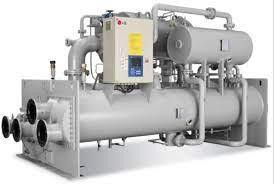Water cooled chillers have become an essential HVAC component of a wide variety of commercial facilities, including hotels, restaurants, hospitals, sporting arenas, industrial and manufacturing plants, etc. The industry has long recognized that chiller systems represent the single largest consumer of electrical usage in most facilities. They can easily consume more than 50% of the total electrical usage during seasonal periods. According to the US Department of Energy (DOE), chillers can combine to use approximately 20% of the total electric power generated in North America. Moreover, the DOE estimates that chillers can expend up to 30% in additional energy usage due to various operational inefficiencies. These acknowledged inefficiencies cost companies and building facilities billions of dollars annually.
How Does a Chiller Work?
A chiller works on the principle of vapor compression or vapor absorption. Chillers provide a continuous flow of coolant to the cold side of a process water system at a desired temperature of about 50°F (10°C). The coolant is then pumped through the process, extracting heat out of one area of a facility (e.g., machinery, process equipment, etc.) as it flows back to the return side of the process water system.
A chiller uses a vapor compression mechanical refrigeration system that connects to the process water system through a device called an evaporator. Refrigerant circulates through an evaporator, compressor, condenser and expansion device of a chiller. A thermodynamic process occurs in each of above components of a chiller. The evaporator functions as a heat exchanger such that heat captured by the process coolant flow transfers to the refrigerant. As the heat-transfer takes place, the refrigerant evaporates, changing from a low-pressure liquid into vapor, while the temperature of the process coolant reduces.
The refrigerant then flows to a compressor, which performs multiple functions. First, it removes refrigerant from the evaporator and ensures that the pressure in the evaporator remains low enough to absorb heat at the correct rate. Second, it raises the pressure in outgoing refrigerant vapor to ensure that its temperature remains high enough to release heat when it reaches the condenser. The refrigerant returns to a liquid state at the condenser. The latent heat given up as the refrigerant changes from vapor to liquid is carried away from the environment by a cooling medium air or water cooled chiller.
Types of Chillers:
As described, two different cooling mediums (air or water) can facilitate the transfer of the latent heat given up as the refrigerant changes from vapor to liquid. Thus, chillers can use two different types of condensers, air-cooled and water-cooled.
Air-cooled condensers resemble the “radiators” that cool automobile engines. They use a motorized blower to force air across a grid of refrigerant lines. Unless they are specially designed for high-ambient conditions, air-cooled condensers require ambient temperatures of 95°F (35°C) or below to operate effectively.
Water-cooled chiller condensers perform the same function as air-cooled condensers, but require two steps to complete the heat transfer. First, heat moves from refrigerant vapor into the condenser chiller. Then, the warm condenser water is pumped to a cooling tower where the process heat is ultimately discharged to the atmosphere.

